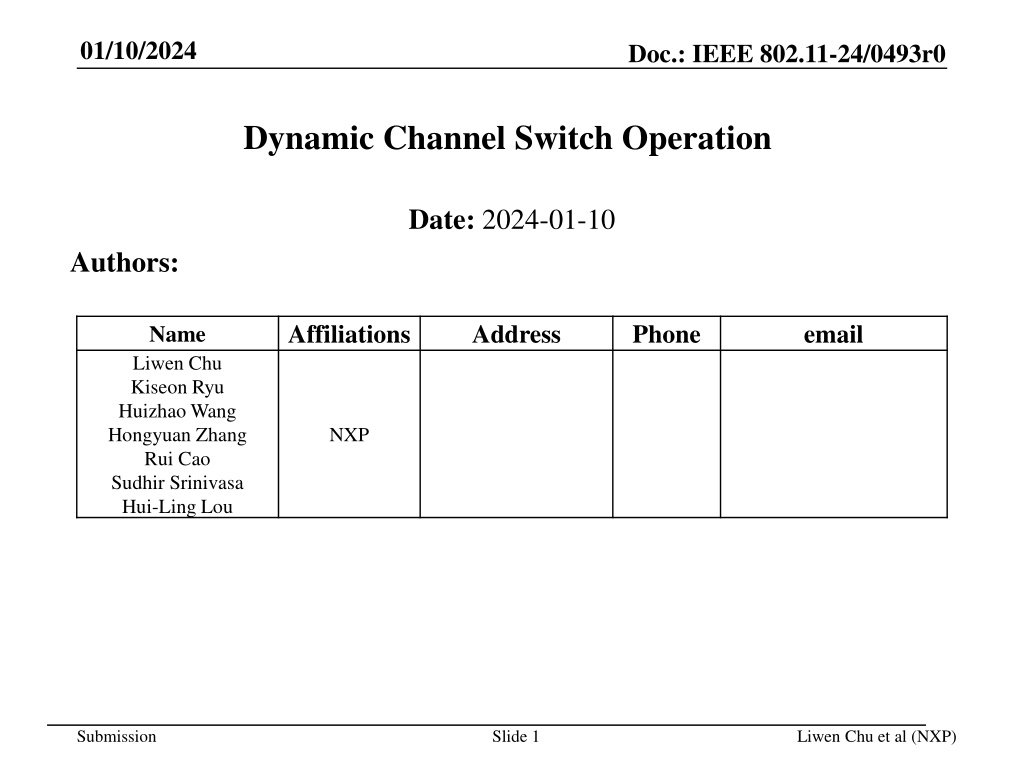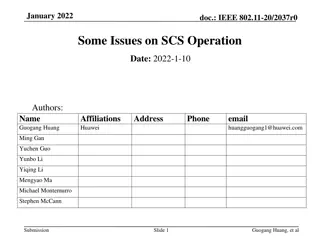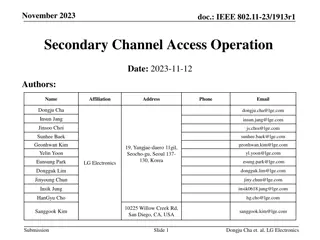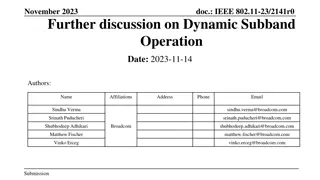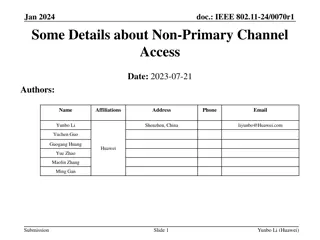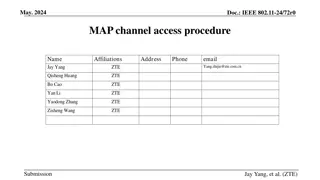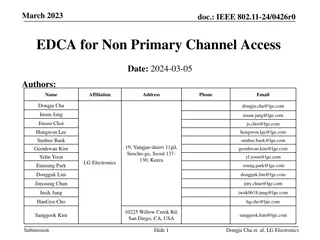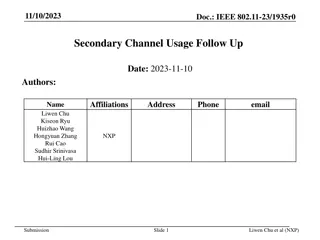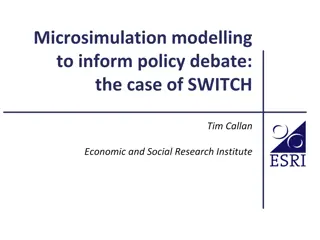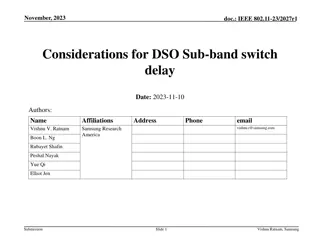Dynamic Channel Switch Operation in IEEE 802.11-24 Standard
STAs in IEEE 802.11-24 can dynamically switch to secondary channels per the AP's request for frame exchanges. The process involves soliciting control frames, determining parking channels, managing frame exchanges, and switching back to the primary channel at the end of a TXOP. Various examples illustrate the channel switching scenarios and considerations. Improvements, such as maintaining Basic NAV Timer with BW information, are suggested for more efficient channel utilization.
Download Presentation

Please find below an Image/Link to download the presentation.
The content on the website is provided AS IS for your information and personal use only. It may not be sold, licensed, or shared on other websites without obtaining consent from the author. Download presentation by click this link. If you encounter any issues during the download, it is possible that the publisher has removed the file from their server.
E N D
Presentation Transcript
01/10/2024 Doc.: IEEE 802.11-24/0493r0 Dynamic Channel Switch Operation Date: 2024-01-10 Authors: Affiliations Address Phone email Name Liwen Chu Kiseon Ryu Huizhao Wang Hongyuan Zhang Rui Cao Sudhir Srinivasa Hui-Ling Lou NXP Submission Slide 1 Liwen Chu et al (NXP)
01/10/2024 Doc.: IEEE 802.11-24/0493r0 Recap: Dynamic Channel Switch STAs can dynamically switch to secondary channels per associated AP s request for the frame exchanges per TXOP. The AP notifies a STA the secondary channels where the STA will park within the TXOP. Submission Slide 2 Liwen Chu et al (NXP)
01/10/2024 Doc.: IEEE 802.11-24/0493r0 Soliciting Control Frame and STA s Parking Channel We agree to use Trigger frame, e.g. MU-RTS, BSRP/BQRP, as the initiating frame to initiate STAs channel switch. Each STA that supports dynamic channel switch announces the padding time for STA s switch from primary channel to the secondary channel. The RU (RU) being allocated to a STA in the initiating frame that triggers the STA s dynamic channel switch decides the STA s parking secondary channel(s). Example 1: in a 160MHz BSS, if a 20MHz STA acquires a 26-tone RU in 8th secondary channel in a frame exchange that trigger STA s dynamic channel switch in a TXOP, the STA parks in 8th secondary channel in the TXOP. Example 2: in a 160MHz BSS, if a STA with 40MHz operating BW acquires a 52-tone RU in 5th secondary channel in a frame exchange that trigger STA s dynamic channel switch in a TXOP, the STA parks in 5th + 6th secondary channels in the TXOP. Example 3: in a 160MHz BSS, if a STA with 80MHz operating BW acquires a 52-tone RU in 5th secondary channel in a frame exchange that trigger STA s dynamic channel switch in a TXOP, the STA parks in 5th + 6th + 7th + 8th secondary channels in the TXOP. Example 4: in a 80MHz BSS, if a 20MHz STA with acquires a 52-tone RU in 3rd secondary channel in a frame exchange that trigger STA s dynamic channel switch in a TXOP, the STA parks in 3rd secondary channels in the TXOP. Slide 3 Submission Liwen Chu et al (NXP)
01/10/2024 Doc.: IEEE 802.11-24/0493r0 Frame Exchanges and Switching Back to Primary Channel It is not allowed to have a frame exchange that no TXOP responder is solicited in primary channel. At the end of the TXOP, a STA that switches back to the primary channel doesn t need to do the medium synchronization. A STA notifies the AP its transition delay from secondary channel to the primary channel. At the end of the TXOP, a STA as the TXOP responder that switched to the secondary channel and is not EMLSR/EMLMR STA switches back to the primary channel. if an EMLSR/EMLMR STA detects a failed frame exchange or received a frame that is not addressed to the STA, the STA switch back to the primary channel Submission Slide 4 Liwen Chu et al (NXP)
01/10/2024 Doc.: IEEE 802.11-24/0493r0 NAV Timer with BW Information Per the baseline rules, if the Basic NAV Timer is not 0, the TXOP responder can t transmit the responding frame although TXOP responder switch to the secondary channels that are idle. One improvement could be that a STA can maintain its Basic NAV timer with BW information. If the switched secondary channels of a STA are not covered by the BW of the STA s non-zero basic NAV timer and the PHY CCA within SIFS before transmitting the responding frame indicates the medium idle of the switched secondary channels, the STA can transmit the responding frame. Basic NAV Timer operation: If a received OBSS PPDU BW is wider than the NAV timer, the BW of the basic NAV timer is set to the BW of the received OBSS PPDU. If the received OBSS frame or OBSS PPDU indicates a TXOP duration that is longer than the value of the basic NAV timer at the end of the received OBSS PPDU, the NAV timer is set to the Duration in received OBSS frame or the PHY header of the received OBSS PPDU at the end of the received PPDU. Submission Slide 5 Liwen Chu et al (NXP)
01/10/2024 Doc.: IEEE 802.11-24/0493r0 Dynamic Channel Puncture vs Dynamic Channel Switch When a STA switches to a group of secondary channels and one of them is dynamically punctured, the STA may miss the PPDU addressed to it since the STA use the punctured channel to start the PPDU decoding. a STA with 20MHz operating BW switches to a secondary channel has no such issue. Once the secondary channel that a 20MHz STA switch to dynamically is punctured in a frame exchange, the STA will not be scheduled in the frame exchange. Solution: Option 1: In a TXOP, it is ok to do dynamic channel puncture for the frame exchange (e.g. BSRP Trigger + QoS Null) that solicits the STAs to do dynamic channel switch. In the following frame exchanges of the TXOP, the further channel puncture is not allowed. A variant to this is that the secondary channels on which no STAs switch dynamically can be punctured. Submission Slide 6 Liwen Chu et al (NXP)
01/10/2024 Doc.: IEEE 802.11-24/0493r0 Dynamic Channel Puncture vs Dynamic Channel Switch Solution: Option 2: An AP announces the subchannels of its BSS where a subchannel include multiple 20MHz channels (primary channel and/or secondary channels). Each subchannel without primary channel has an anchor channel that is never punctured. In a TXOP, it is ok to do dynamic channel puncture for the secondary channels other than anchor channel(s) for the frame exchange (e.g. BSRP Trigger + QoS Null) that solicits the STAs to do dynamic channel switch. In the following frame exchanges of the TXOP, the further channel puncture is allowed for the secondary channels other than anchor channel(s). Option 3: The dynamic channel puncture is not allowed in the frame exchanges with STAs switching to secondary channels. Submission Slide 7 Liwen Chu et al (NXP)
01/10/2024 Doc.: IEEE 802.11-24/0493r0 Initiating Control Frame for Dynamic Channel Switch BSRP/BQRP Trigger + QoS Null provide less protection since the responding QoS Null is carried in UHR TB PPDU. In dynamic channel switch operation, some responding STAs may switch to secondary channels to transmit CTS frames while one or multiple STAs transmit CTS frame(s) in non-HT duplicate PPDU(s) that covers the primary channel. If no STAs transmits CTS frame(s) in non-HT duplicate PPDU(s) that covers the primary channel while the STAs switched to secondary channels transmit CTS, the AP may assume the failed MU-RTS + CTS frame exchange the OBSS STAs/APs that receive CTS in secondary channel assume the medium busy. One exception is that if the AP can do the parallel PHY header decoding, the AP can detect CTS in secondary channels although the primary channel has no responding CTS. TXOP per Duration field TXOP per Duration field MU-RTS CTS STA0, 1 detect medium busy Primary 20MHz channel BSS operating channel Request STA2,3 to switch to secondary 80MHz channel while STA0, 1 stay in primary 80MHz channel. Submission Slide 8 Liwen Chu et al (NXP)
01/10/2024 Doc.: IEEE 802.11-24/0493r0 Double MU-RTS + CTS or MU-RTS+ CTS Followed by BSRP/BQRP Trigger + QoS Null An AP uses the first MU-RTS to solicit CTS from all the STAs as the TXOP responders that stay in primary channel within the TXOP. If the AP receives CTS, the AP transmits another MU-RTS or BSRP Trigger (or BQRP Trigger) + QoS Null to request STAs dynamic channel switch. TXOP per Duration field TXOP per Duration field BSRP Trigger MU-RTS CTS QoS Null A-MPDU from STA2 A-MPDU from STA3 A-MPDU from STA0 Primary 20MHz channel A-MPDU from STA1 UHR TB PPDU M-BA Basic Trigger BSS operating channel AP requests CTS from STA0, 1 Without dynamic channel switch. AP requests STA2,3 to switch to secondary 80MHz channel while STA0, 1 stay in primary 80MHz channel. Submission Slide 9 Liwen Chu et al (NXP)
01/10/2024 Doc.: IEEE 802.11-24/0493r0 STA s CF-End When a STA that switches to a secondary channel per the initiating MU-RTS and transmits CTS doesn t receive the following PPDU from the AP after SIFS + one time slot or another defined IFS, the STA can transmit CF-End to let its neighbor STAs/APs to reset their NAV timers. If a STA switched to the secondary channels transmits the CF-End, the non-HT duplicate PPDU to carry the CF-End has the same BW as the solicited CTS of the STA. The multiple STAs may transmit CF-End at the same secondary channel. The same data rate (defined by the spec, e.g. 6Mbps), scramble initial value (e.g. the scramble initial value of MU-RTS) need to be used by all the STAs that transmits CF-End. TXOP per Duration field TXOP per Duration field CF-End MU-RTS CTS STA2, 3 can t detect the PPDU from the AP Primary 20MHz channel BSS operating channel Request STA2,3 to switch to secondary 80MHz channel while STA0, 1 stay in primary 80MHz channel. Submission Slide 10 Liwen Chu et al (NXP)
01/10/2024 Doc.: IEEE 802.11-24/0493r0 Summary The dynamic channel switch is discussed in the presentation: Various Trigger frames are used to announce the dynamic channel switch. The switching delay at the beginning of the channel switch and the end of the frame exchanges on the switched channel are announced. The potential issues of various Trigger frame for dynamic channel switch are discussed. The NAV timer and dynamic channel puncture under DSO are discussed. We prefer to reuse various Trigger frames for the dynamic channel switch. Submission Slide 11 Liwen Chu et al (NXP)
